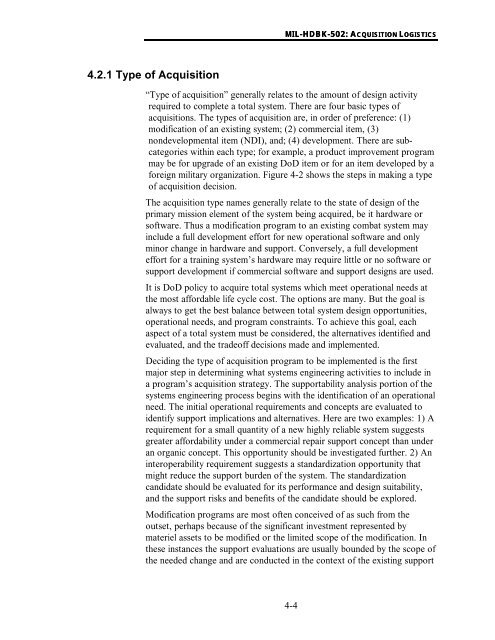MIL-HDBK-502 - Barringer and Associates, Inc.
MIL-HDBK-502 - Barringer and Associates, Inc.
MIL-HDBK-502 - Barringer and Associates, Inc.
Create successful ePaper yourself
Turn your PDF publications into a flip-book with our unique Google optimized e-Paper software.
<strong>MIL</strong>-<strong>HDBK</strong>-<strong>502</strong>: ACQUISITIONALOGISTICS4.2.1 Type of Acquisition“Type of acquisition” generally relates to the amount of design activityrequired to complete a total system. There are four basic types ofacquisitions. The types of acquisition are, in order of preference: (1)modification of an existing system; (2) commercial item, (3)nondevelopmental item (NDI), <strong>and</strong>; (4) development. There are subcategorieswithin each type; for example, a product improvement programmay be for upgrade of an existing DoD item or for an item developed by aforeign military organization. Figure 4-2 shows the steps in making a typeof acquisition decision.The acquisition type names generally relate to the state of design of theprimary mission element of the system being acquired, be it hardware orsoftware. Thus a modification program to an existing combat system mayinclude a full development effort for new operational software <strong>and</strong> onlyminor change in hardware <strong>and</strong> support. Conversely, a full developmenteffort for a training system’s hardware may require little or no software orsupport development if commercial software <strong>and</strong> support designs are used.It is DoD policy to acquire total systems which meet operational needs atthe most affordable life cycle cost. The options are many. But the goal isalways to get the best balance between total system design opportunities,operational needs, <strong>and</strong> program constraints. To achieve this goal, eachaspect of a total system must be considered, the alternatives identified <strong>and</strong>evaluated, <strong>and</strong> the tradeoff decisions made <strong>and</strong> implemented.Deciding the type of acquisition program to be implemented is the firstmajor step in determining what systems engineering activities to include ina program’s acquisition strategy. The supportability analysis portion of thesystems engineering process begins with the identification of an operationalneed. The initial operational requirements <strong>and</strong> concepts are evaluated toidentify support implications <strong>and</strong> alternatives. Here are two examples: 1) Arequirement for a small quantity of a new highly reliable system suggestsgreater affordability under a commercial repair support concept than underan organic concept. This opportunity should be investigated further. 2) Aninteroperability requirement suggests a st<strong>and</strong>ardization opportunity thatmight reduce the support burden of the system. The st<strong>and</strong>ardizationc<strong>and</strong>idate should be evaluated for its performance <strong>and</strong> design suitability,<strong>and</strong> the support risks <strong>and</strong> benefits of the c<strong>and</strong>idate should be explored.Modification programs are most often conceived of as such from theoutset, perhaps because of the significant investment represented bymateriel assets to be modified or the limited scope of the modification. Inthese instances the support evaluations are usually bounded by the scope ofthe needed change <strong>and</strong> are conducted in the context of the existing support4-4
















